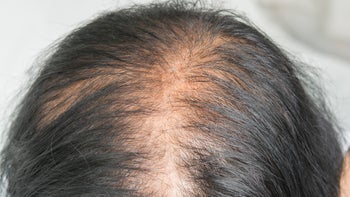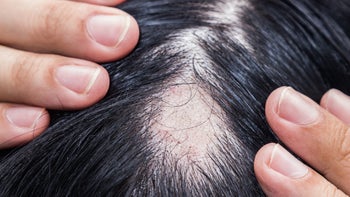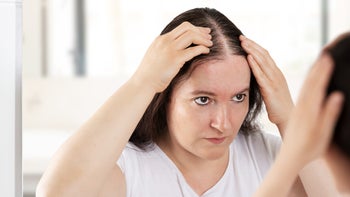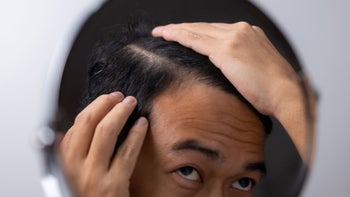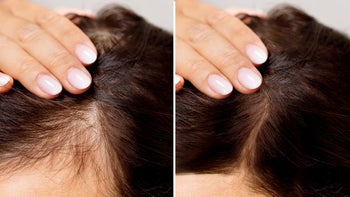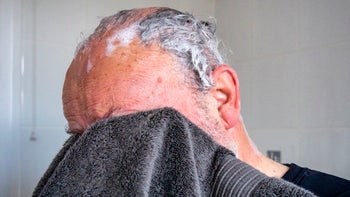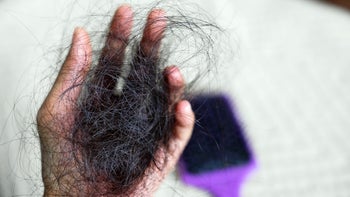
What Causes Hair Loss? Exploring the 10 Most Common Reasons for Hair Loss
Key takeaways:
For most people, hair thinning is a normal part of aging. Some people are more prone to hair thinning and hair loss than others, and this probably comes down to genetics.
There are other more serious causes of hair thinning and hair loss (alopecia). These include health issues, hormone changes, some medications, a lack of certain nutrients, and stressful life events.
Inflammation (like from autoimmune skin diseases) and certain hair styles can cause hair to fall out. If not treated early, this can lead to permanent hair loss.
Table of contents
Hair loss can be devastating. If you think your hair might be thinning, know that you’re not alone. Hair loss is one of the most common issues dermatologists see. Many people think it only happens to men, but women of all ages can experience hair loss.
The medical term for hair loss is “alopecia,” regardless of the cause. There are different causes of alopecia, and some are hereditary (they tend to run in families). The good news is: Treatment is possible in many cases.
But the first step is to figure out the cause of your hair loss. A healthcare professional may be able to diagnose it just by looking at your scalp and asking you some questions. In other situations, they may need to do a small skin biopsy (where they take a small skin sample to evaluate under a microscope). Depending on the cause, alopecia may be curable or reversible, so getting diagnosed and treated early is important.
Search and compare options
Let’s take a closer look at 10 common causes of hair loss.
1. Age
Almost everyone — both men and women — will notice hair loss and hair thinning as they age. Cells continually grow and die off at all ages. But with age, cells die off more quickly than they regenerate. This is why people get weaker bones and thinner skin. And it’s a similar process for hair.
As you age, you also produce less oil in your scalp, which can make hair weak and brittle. This can also contribute to overall hair loss and thinning.
Some people may experience more severe hair loss as they age. This condition is known as androgenetic alopecia, which is also called female- or male-pattern hair loss. We’ll talk more about that below.
2. Genetics
The most common type of hair loss — androgenetic alopecia — is hereditary and related to age. It affects more than 50 million men and 30 million women in the U.S. This is a more extreme form of hair loss that usually begins in young adulthood and gradually progresses with age. It can have different patterns depending on who it affects:
Male-pattern hair loss often starts at the temples and expands to the top of the scalp. There may also be a little thinning at the top of the head.
Female-pattern hair loss usually first becomes noticeable where you divide your hair, but there’s gradual thinning all over. The hairline typically stays the same, but the hair part can widen.
Hair loss in women may be due to different factors, depending on age. Learn about the various causes of hair loss in women, as well as their treatments.
Male-pattern baldness is very common in men as they age. While testosterone plays a factor, genetics are mostly to blame.
Telogen effluvium is hair loss linked to stress. This reversible cause of hair thinning or loss can be triggered by any physical or emotional stressor.
You may have heard that this kind of hair loss is inherited from your mother’s side of the family. But research shows that many genes (not only the ones on the X chromosome) affect how likely someone is to have this type of hair loss.
3. Hormonal changes
Conditions like polycystic ovary syndrome (PCOS) and congenital adrenal hyperplasia (CAH) cause higher androgen levels. This can lead to female-pattern hair loss. These conditions usually have other symptoms, such as acne, irregular periods, and changes in face or body hair growth.
Other things that can cause dramatic changes in hormone levels may also affect hair growth. Examples include:
Pregnancy
Childbirth
Menopause
Even changing medication routines can cause your hair to thin if your medications affect your hormone levels. For example, some women who stop taking birth control pills can experience hair loss. Fortunately, in most of these cases, you can slow down or reverse the hair loss with proper treatment.
4. Stressful life events
Out of nowhere, you notice a lot of hair falling out. You see it on your pillow, on the floor, on your clothes, and stuck in the shower drain. Hair seems to come out so easily that you may be afraid to brush it. The medical term for this is “telogen effluvium.”
Telogen effluvium is a response to stress. Excess hair shedding starts 2 to 3 months after a stressful physical or emotional event and peaks about 4 to 5 months later. Over time, the body readjusts and hair gradually stops falling out. Within 6 to 9 months, things go back to normal.
Stressful life events, like losing a loved one, going through surgery, or being diagnosed with a serious illness, can all increase the risk for hair loss. But hair loss itself can be stressful, which can lead to a vicious cycle.
Most cases of telogen effluvium are temporary and don’t require treatment.
5. Nutritional deficiencies
In some situations, hair loss can happen because of nutritional deficiencies. Low levels of iron, vitamin D, and zinc have all been linked to excessive shedding and hair loss.
In most cases, dietary supplements can easily correct vitamin deficiencies. A healthcare professional can look for vitamin and mineral deficiencies with a blood test before recommending supplements, so it’s important to talk to them before starting any new supplements.
6. Autoimmune disease
Certain autoimmune conditions can cause hair loss when inflammation attacks healthy hair follicles, causing hair to fall out. Depending on how severe it is, hair loss can be temporary or permanent. Here’s a look at a few common autoimmune conditions that can affect your hair:
Alopecia areata usually shows up as one or more coin-sized, hairless patches. These can happen anywhere on the body. It can be mild (just a few patches), or it can affect the whole scalp, face, and body. There is no cure. But, in most cases, the hair comes back on its own over time. Different treatments, like steroid injections or the new medication Olumiant (baricitinib), can help hair to regrow faster.
Lupus erythematosus can affect many parts of the body, including skin and hair. Some people with lupus may experience thinning hair throughout their scalp. Others may notice hair loss associated with a rash that is thick, scaly, and red or brown in color. Depending on the type of hair loss, hair may regrow with lupus treatment.
Hashimoto’s thyroiditis is the leading cause of hypothyroidism in the U.S. Hair thinning and loss are common with thyroid dysfunction. This may be due to inflammation or changes in the hair growth cycle.
7. Infection
Infections that affect the scalp can cause hair to fall out. This happens when bacteria, yeast, or fungi overgrow and invade hair follicles. You might see pus bumps, redness, and scaling. The scalp can feel itchy or even painful.
Fungal infections of the scalp are highly contagious, and they’re the most common cause of hair loss in children. The good news is, most scalp infections are curable with the right antibiotic or antifungal medication. Without treatment, these infections can lead to permanent scarring. So if you notice any symptoms of scalp infection, see your primary care provider or dermatologist right away.
8. Medication side effects
Certain medications can cause hair thinning as a side effect. It doesn’t happen to everyone who takes these medications, but hair loss can happen with some popular ones, including:
Some cholesterol-lowering medications (like atorvastatin and simvastatin)
Some blood pressure medications (like captopril and lisinopril)
The antacid cimetidine (Tagamet)
The gout medication colchicine (Colcrys)
The steroids testosterone and progesterone
Weight-loss medications like semaglutide (Ozempic) and tirzepatide (Zepbound)
Tell your prescriber right away if you notice hair loss after you start a new medication. They can recommend a change to something else and help you stop the problem medication safely.
9. Chemotherapy and radiation
Hair loss can be a very real fear for many people who have received a diagnosis of cancer and need chemotherapy or radiation. Chemotherapy medications kill cells in the body that grow quickly so that they don’t form tumors or spread. But, because cells in hair follicles also grow quickly, chemotherapy can also affect your hair.
Radiation therapy, another cancer treatment, can also cause hair loss. But while chemotherapy can cause hair loss throughout the body, radiation therapy usually only affects the area that’s treated.
With both types of treatments, hair loss is generally temporary. So you can expect your hair to regrow a few months after the end of treatment.
10. Traumatic hairstyling
So far, we have discussed nonscarring types of hair loss, where the hair follicles are still alive and hair can regrow. This is in contrast to scarring hair loss, where hair follicles are destroyed and hair can’t regrow.
Some hairstyling practices can cause scarring hair loss called traction alopecia. If they’re not stopped early, they can cause significant hair loss that can’t be regrown. Examples of these practices include:
Heat styling
Chemical hair treatments
Tight hairstyles like braids and ponytails
Hair extensions
Some shampoos that contain the chemical formaldehyde have been linked to hair loss, too. If you notice hair loss after starting a new shampoo, stop using it and try a different product after making sure it doesn’t have any formaldehyde in it.
When to get help for hair loss
It’s totally normal to lose about 50 to 100 hairs a day. But losing more than that may mean there’s excess shedding. When you lose more than you replace, you’ll start to see signs of hair thinning and hair loss.
Signs that you could have abnormal hair loss are:
Hair thinning, which you might see in a thinner ponytail
Bald spots that grow over time
A receding hairline and/or loss of clear edges
A widening hair part
Sometimes hair loss or thinning can signal a more serious underlying medical problem. Get checked out by a healthcare professional if you also have any of these:
Other skin changes on your face or body
General symptoms like feeling very cold or tired all the time
Unexpected weight loss
Your primary care provider or dermatologist can evaluate you to see if additional testing might be helpful for a diagnosis, or recommend treatment. But don’t delay — treatments work best when started early.
Frequently asked questions
It depends on the cause. For example, scarring types of hair loss cause destruction of the hair follicles, so hair regrowth isn’t possible. On the other hand, hair loss due to stress or hormonal changes are often temporary.
Again, it depends on the cause. Hair loss due to male-pattern baldness or aging isn’t preventable. But you can take steps to help prevent some types of hair loss. For example, by not sharing hats and brushes with others, you decrease your risk of fungal scalp infection, and by avoiding certain hairstyling practices, you can decrease the risk of traction alopecia.
It’s unclear. Theoretically, the constant rubbing or tightness of a hat could cause the same kind of trauma to the hair follicles as traction alopecia. Studies of identical twins found that wearing a hat was linked to hair loss in men but not women. So if you’re worried about hair loss, it might be a good idea to choose a loose-fitting head covering. you see your dermatologist, they’ll need to find the cause of your hair loss. This may include a physical exam of your hair and scalp, a scalp biopsy, or blood tests to check for issues like thyroid problems or vitamin deficiencies. Once your provider knows the cause, they’ll give you treatment options. The sooner you start the right treatment, the better chance you have of regrowing your hair. Hair loss may not always have a cure. But medications can help if you use them early enough.
The bottom line
If you’re experiencing hair loss, don’t panic. First, see a board-certified dermatologist as soon as possible. It’s best not to waste time on home remedies and hair supplements that may not work (or even do more harm than good).
When you see your dermatologist, they’ll need to find the cause of your hair loss. This may include a physical exam of your hair and scalp, a scalp biopsy, or blood tests to check for issues like thyroid problems or vitamin deficiencies. Once a healthcare professional knows the cause, they’ll give you treatment options. The sooner you start the right treatment, the better chance you have of regrowing your hair. Hair loss may not always have a cure. But medications can help if you use them early enough.
Why trust our experts?



References
American Osteopathic College of Dermatology. (n.d.). Biopsy.
Cardoso, C. O., et al. (2021). Topical treatment for scarring and non-scarring alopecia: An overview of the current evidence. Clinical, Cosmetic and Investigational Dermatology.
Encyclopedia Britannica. (2025). Androgen.
Endocrine Society. (2022). Congenital adrenal hyperplasia.
Gatherwright, J., et al. (2012). The contribution of endogenous and exogenous factors to female alopecia: A study of identical twins. Plastic and Reconstructive Surgery.
Gatherwright, J., et al. (2013). The contribution of endogenous and exogenous factors to male alopecia: A study of identical twins. Plastic and Reconstructive Surgery.
Guo, E. L., et al. (2017). Diet and hair loss: Effects of nutrient deficiency and supplement use. Dermatology Practical & Conceptual.
Hagenaars, S. P., et al. (2017). Genetic prediction of male pattern baldness. PLoS Genetics.
Ludmann, P., et al. (2024). Hairstyles that pull can lead to hair loss. American Academy of Dermatology Association.
Nejad, K. D., et al. (2022). Dermoscopic findings of alopecia in patients with hypothyroidism. International Journal of Endocrinology and Metabolism.
NYU Langone Health. (n.d.). Types of hair loss.




